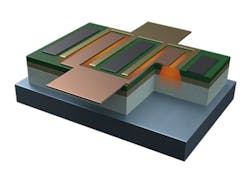Raytheon, Northrop Grumman to enhance power amplifiers for electronic warfare (EW), RF and microwave uses
ARLINGTON, Va. – U.S. military researchers are looking to two prime U.S. defense contractors to limit waste heat in gallium nitride (GaN)-based power amplifiers that can limit the performance and lifetimes of military radar, electronic warfare (EW), communications, and other RF and microwave systems.
Officials of the U.S. Defense Advanced Research Projects Agency (DARPA) awarded contracts last month to Raytheon Technologies Corp. (RTX) and to Northrop Grumman Corp for the Technologies for Heat Removal in Electronics at the Device Scale (THREADS) program.
THREADS seeks to develop RF and microwave microelectronics technologies that will overcome the thermal limitations that can prevent transistors from operating reliably at RF output power density close to their fundamental electronic limits.
Raytheon won a $14.9 million THREADS contract on 29 Sept. 2023, and Northrop Grumman won a $14.2 million THREADS contract on 13 Sept. 2023.
The performance of radar and communication systems depends on the signal-to-noise ratio achievable at the receiver, which is proportional to the RF output power of the transmitter. The size of RF apertures in military systems often are limited, so the only way to increase range is by increasing the RF output power of the transmitter power amplifier.
The RF output power densities of today’s military RF transmitters substantially are thermally limited to below their theoretical electronic limits. Wide-bandgap transistors like gallium nitride (GaN) were developed to improve output power in power amplifiers by as much as five times compared to older gallium arsenide (GaAs) transistor technology.
Yet limiting increases in sustained GaN power output continues to be excessive waste heat in the transistor channel layer, which causes elevated channel temperatures and device damage.
Achieving the transistor output power near the GaN fundamental electronic limit while maintaining a channel temperature below the nominal maximum temperature of 225 degrees Celsius requires a significant reduction in the thermal resistance of the transistor, while preserving electronic properties of wide-bandgap semiconductors.
In the THREADS program, Raytheon and Northrop Grumman will focus on achieving high power density by reducing transistor thermal resistance in two ways: reducing thermal resistance within the device while maintaining good channel current transport properties; and moving heat away from high-power transistors more efficiently without degrading RF performance.
The companies will demonstrate efficient X-band transistors and power amplifiers. an eight-times reduction in transistor thermal resistance; and reliable operation with a mean-time-to-failure of 106 hours at 225 C channel temperature.
Raytheon and Northrop Grumman engineers will try to reduce thermal resistance within the device while maintaining good channel current transport properties by reducing interfacial and thin film thermal resistance within the device's epitaxial layer stack. THREADS also will develop new ways to spread waste heat and reduce transistor thermal resistance to maintain channel temperature of 225 C.
The companies will incorporate electro-thermal co-design, modeling, and simulation to guide device optimization. THREADS is a four-year program.
For more information contact Raytheon online at www.rtx.com/raytheon/what-we-do/advanced-technology/microelectronics, Northrop Grumman at www.northropgrumman.com/what-we-do/microelectronics-space-park, or DARPA at www.darpa.mil.
About the Author
John Keller
Editor-in-Chief
John Keller is the Editor-in-Chief, Military & Aerospace Electronics Magazine--provides extensive coverage and analysis of enabling electronics and optoelectronic technologies in military, space and commercial aviation applications. John has been a member of the Military & Aerospace Electronics staff since 1989 and chief editor since 1995.
